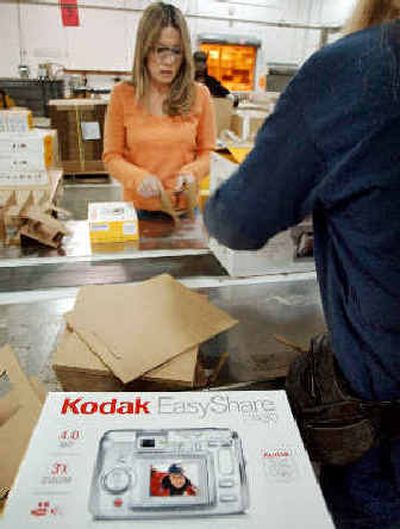Kodak enjoys the moment

ROCHESTER, N.Y. — After a stumbling start in filmless photography, Eastman Kodak Co. has chalked up its first win on home soil in the annual digital-camera derby.
Helped by a late kick, Kodak surged ahead of perennial front-runner Sony Corp. in U.S. digital camera shipments in 2004 — a key achievement by the American picture-taking pioneer as the digital revolution rapidly erodes its fat profits from silver-halide film.
Kodak shipped 4.88 million point-and-shoot digital cameras to domestic retailers last year — 66 percent more than in 2003 — and its market share jumped from 17.9 percent to 21.9 percent, according to data released Wednesday by IDC, a research firm based in Framingham, Mass.
Sony, the Tokyo-based electronics and entertainment giant, shipped 4.33 million cameras, up 21 percent from 2003, but its slice of the U.S. market plunged from 21.7 percent to 19.4 percent, IDC said.
Four other Japanese companies filled out the top seven slots.
Canon Inc. strengthened to a third-place ranking with a 16.1 percent share in 2004, up from 15 percent. Olympus Corp. held onto fourth place, shipping 424,000 more cameras than it did in 2003, but its market share fell to 10.4 percent from 11.6 percent.
Next were Palo Alto, Calif.-based Hewlett-Packard Co. with 8.1 percent, Fuji Photo Film Co. with 8 percent and Nikon Corp. with 6.2 percent, IDC said.
Catapulted by cutthroat competition, digital technology is transforming the $85 billion global photography industry by creating new ways of capturing, storing and developing pictures.
Kodak launched its low-priced, easy-to-use line of digital cameras in 2001 after waiting — some analysts think too long — for a mass-market to clearly develop.
While its digital-camera business was profitable in 2004 for the first time, Kodak is aiming to reap far bigger profits from coated paper, inks, ribbons and other high-margin accessories used to make prints.
“We have set out on a journey to drive ourselves to a leading position in capture,” said Greg Westbrook, general manager of Kodak’s digital-capture business. “With capture doing so well, we continue to pull the printing opportunity along very aggressively as well.”
Digital cameras, a novelty item just five or six years ago, began outselling film cameras in the United States in 2003. They were the most popular electronics gift last year, the Consumer Electronics Association said.
More than 22.3 million digital cameras were shipped nationwide in 2004, up from 16.4 million in 2003, but 2005 projections are still a few weeks away, IDC analyst Christopher Chute said.
“There will be more units sold this year than last year — it’s just a question of whether it’s going to be 5 percent, 15 percent,” he said.
Camera makers took unique advantage of the end-of-year holiday season in the United States. They churned out 9.2 million consumer digital cameras from October to December, up from 7.4 million in last year’s fourth quarter. Kodak shipped 2.4 million units to Sony’s 1.6 million.
Sony’s U.S. market share peaked at 31 percent in 1999 and still held up at 24 percent in 2002.